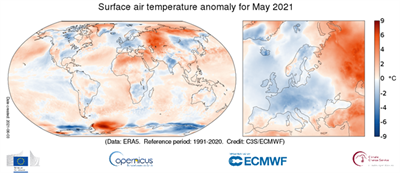May 2021 surface air temperature anomaly relative to the May average temperature for the period 1991-2020. Data source: ERA5. Author: Copernicus Climate Change Service (C3S) / ECMWF. Videos accompanying the maps are available Here.
Copernicus Climate Change Service (C3S), conducted by the European Center for Medium Weather Forecasts in the European Union and publishes monthly climate bulletins that report on changes observed in the world surface air temperatures and ice cover, and in Hydrological variables. All reported results are based on computer-generated analyzes that use billions of measurements from satellites, ships, aircraft and weather stations around the world.
Surface air temperature for May 2021:
- The global average temperature for May 2021 was 0.26°C higher than the 1991-2020 average for May
- For Europe as a whole, May 2021 was 0.46°C lower than the 1991-2020 average
- Temperatures were well above average in western Greenland, northern Africa, the Middle East, and northern and western Russia.
- Below-average temperatures occurred in May over the southern and central United States, parts of northern Canada, southeastern Africa, most of India, eastern Russia, and eastern Antarctica.
The deviation of the surface air temperature for spring (March – May) 2021 compared to the spring average for the period 1991-2020. Data source: ERA5. Source: Copernicus Climate Change Service (C3S) / ECMWF
Spring Temperatures 2021 (March to May)
- The global map of spring temperature deviations (March to May) shows much the same pattern as for May above, for example, large parts of Europe are below average.
- The average spring temperature for Europe was 0.45°C lower than the 1991-2020 average for this season, which means the coldest spring for Europe since 2013.
Map values and data were obtained from the ECMWF Copernicus Climate Change Services ERA5 dataset. Zone averages of temperatures in the European region are only for countries with the following latitude/longitude limits: 25W-40E, 34N-72N.
C3S followed the recommendation of the World Meteorological Organization (WMO) to use the past 30 years to calculate climate averages and was recently changed to the reference period 1991-2020 for its C3S Climate Bulletins. But figures and graphics for both the new and previous periods (1981-2010) are provided for transparency.
More information on climate variables in May and climate updates from previous months as well as high-resolution graphics can be downloaded here: https://climate.copernicus.eu/monthly-climate-bulletins
Videos accompanying the maps are available Here.
More information about the C3S dataset and how it is collected can be found here:
https://climate.copernicus.eu/climate-bulletin-about-data-and-analysis
More information on changing the reference period can be found here:
https://climate.copernicus.eu/new-decade-reference-period-change-climate-data
Answers to frequently asked questions about temperature monitoring can be found here:
https://climate.copernicus.eu/temperature-qas
Media connection
Nuria Lopez
Communication | Copernicus contracts and the press
General manager’s office
European Center for Medium-Range Weather Forecasts
Reading, UK | Bologna, Italy
Email: [email protected]
Phone: +44 (0) 118949 9778
Mobile: +44 (0) 7392277523
Twitter: Tweet embed
Bjorn Mogensen
Oxenstierna Communication
+46 708-184298
[email protected]
About ECMWF and Copernicus
Copernicus is the EU’s finest Earth observations and is based on satellite data in six areas: atmospheric, marine, land, climate change, security and emergency. It provides freely available data and operational services that provide users with reliable and up-to-date information about our planet and its environment. The program is coordinated and managed by the European Commission and implemented in partnership with Member States, the European Space Agency (ESA), the European Organization for the Development of Meteorological Satellites (EUMETSAT) and the European Center for Meteorological Outlook (ECMWF), including the European Union agencies and Mercator Ossian.
ECMWF operates two services of the European Union’s Copernicus Earth Observation Program: the Copernicus Atmospheric Monitoring Service (CAMS) and the Copernicus Climate Change Service (C3S). They also contribute to the Copernican Emergency Management Service (CEMS). The European Center for Medium-Range Weather Forecasts (ECMWF) is an independent intergovernmental organization supported by 34 countries. It is an operational research and service institute that produces and publishes digital weather forecasts to member countries 24/7. This data is available to the national meteorological services of member states. The supercomputer facility (with associated data archives) at the ECMWF is one of the largest of its kind in Europe and member states can use 25% of its capacity for their own purposes.
ECMWF is increasing the number of places in which it does business. In addition to the main office in the UK and the computing center in Italy, new offices focusing on activities implemented in partnership with the European Union, such as Copernicus, will be located in Bonn, Germany starting in the summer of 2021.
Copernicus Atmosphere Watch Service (B): http://atmosphere.copernicus.eu/
Copernicus Climate Change Service website: https://climate.copernicus.eu/
More information about Copernicus: www.copernicus.eu
ECMWF: s webb: https://www.ecmwf.int/
Twitter:
Tweet embed
Tweet embed
Tweet embed
Tags:

“Extreme tv maven. Beer fanatic. Friendly bacon fan. Communicator. Wannabe travel expert.”






More Stories
Azerbaijan is in a multi-billion dollar mess with bribes
Which side does the government stand on bank fraud?
Qvantum has won the British Award for Heat Pump for Apartments